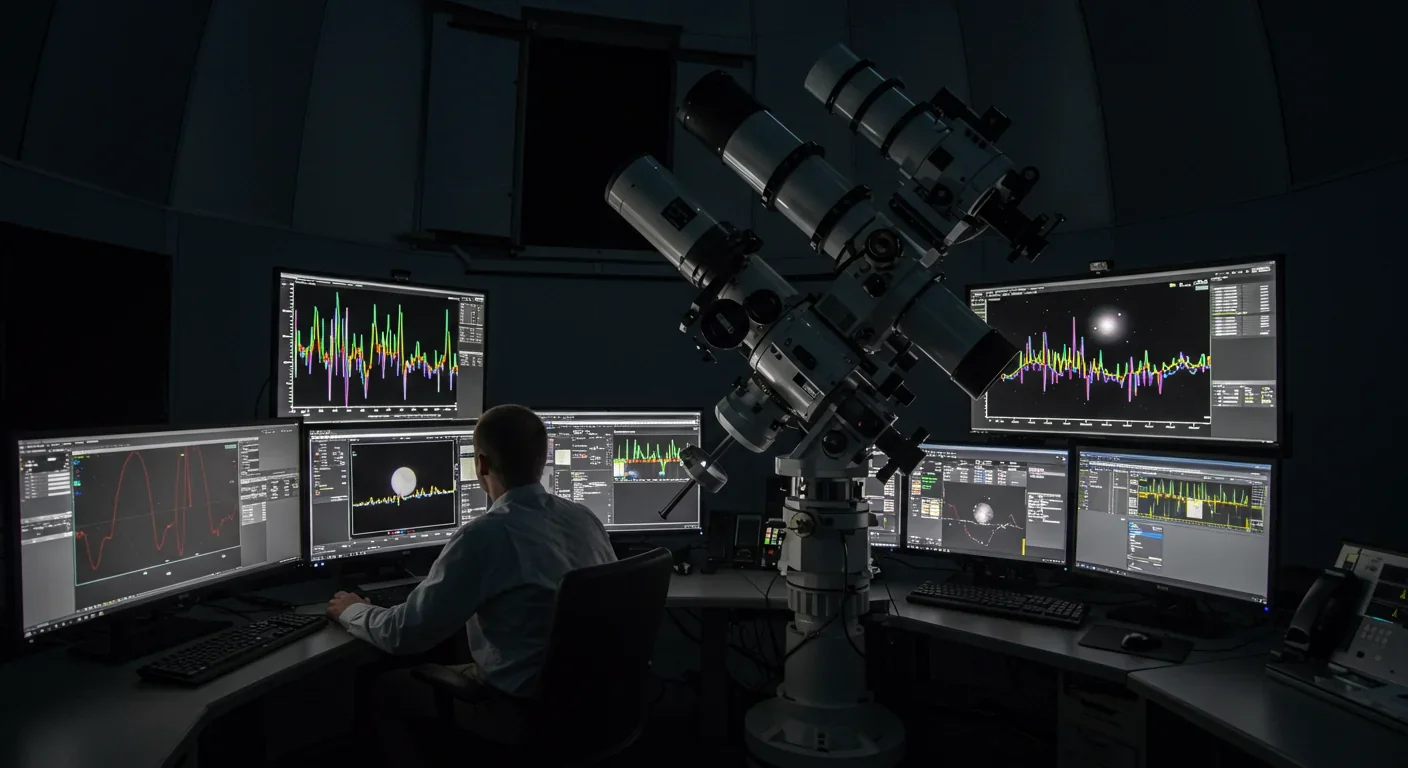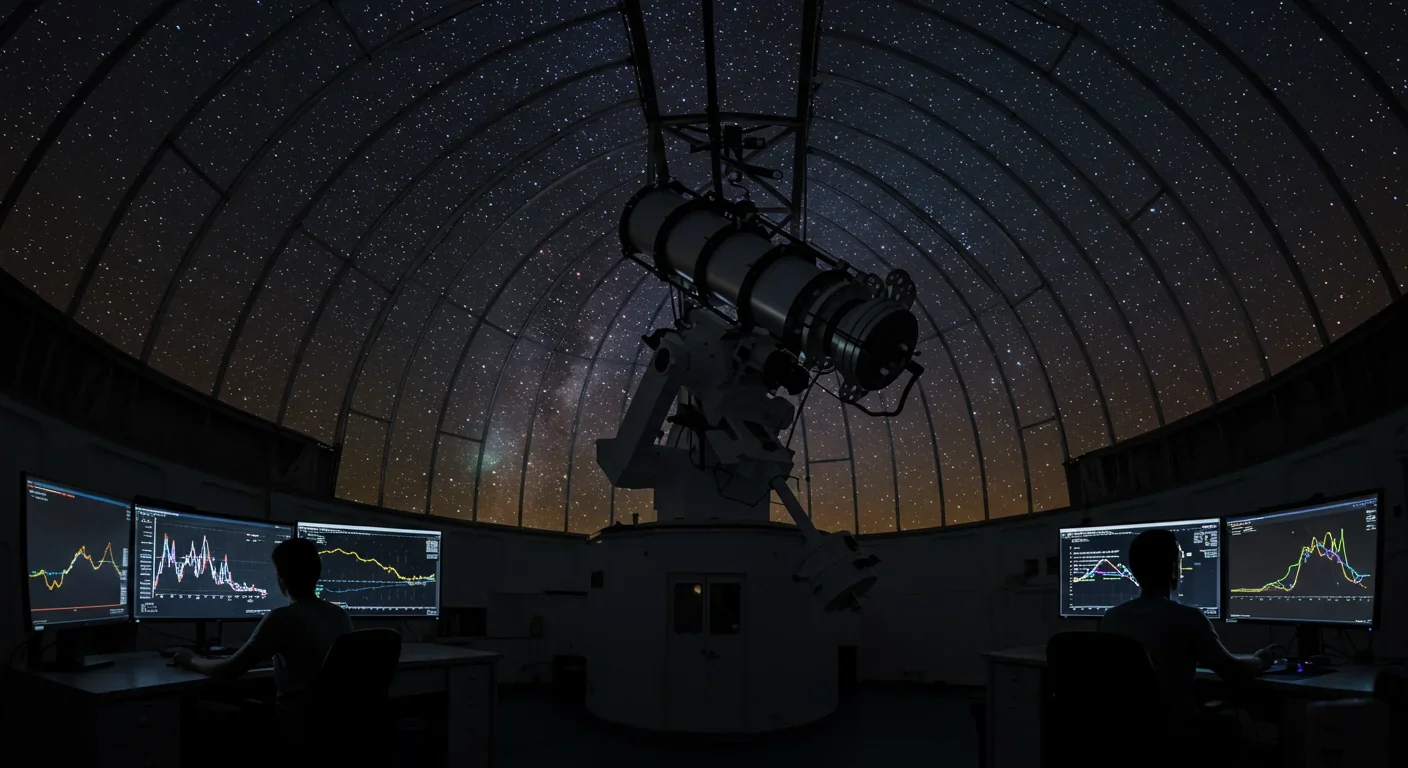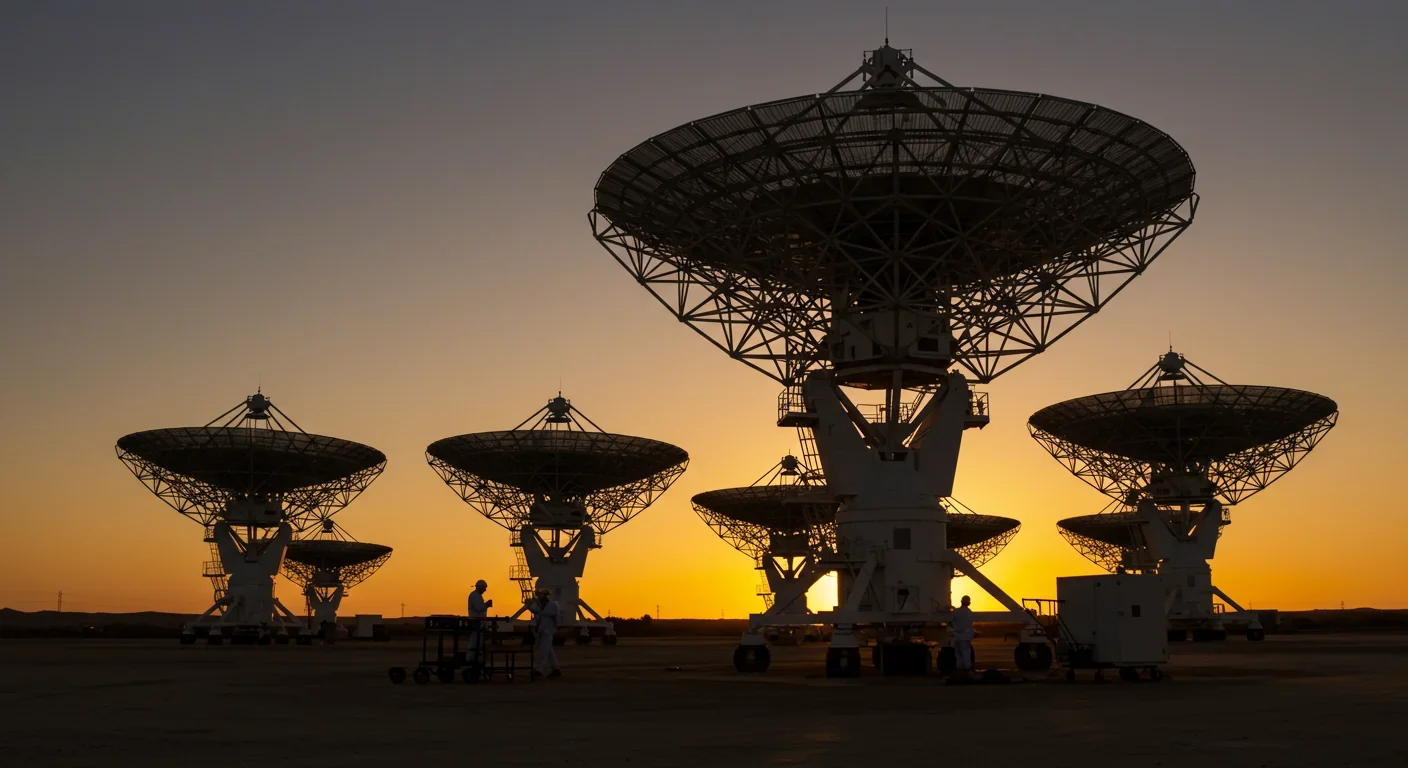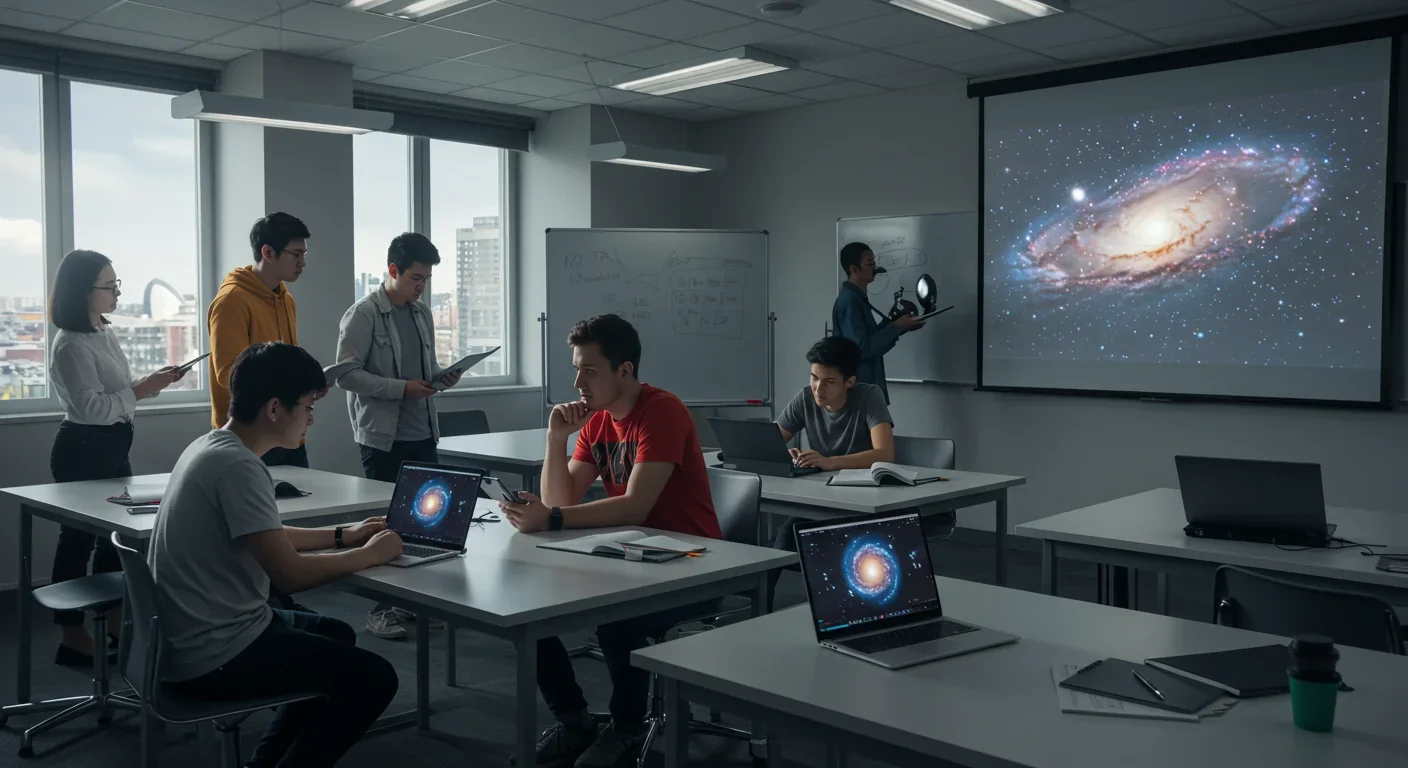White Dwarf Spectroscopy Reveals Destroyed Exoplanets

TL;DR: Tidal disruption events—stars torn apart when they venture too close to supermassive black holes—are transforming our view of black holes from invisible monsters into observable laboratories. By 2030, astronomers expect to detect hundreds annually, revealing black hole masses, spins, and accretion physics. These cosmic deaths produce neutrinos, ultra-high-energy cosmic rays, and multi-wavelength fireworks lasting years. The upcoming Vera C. Rubin Observatory will discover 14,000 TDEs per year, enabling population studies across cosmic time and testing fundamental physics in the strong-gravity regime.

By 2030, astronomers expect to witness hundreds of stars being torn apart by supermassive black holes each year—spectacular cosmic deaths that reveal secrets about the universe's most enigmatic objects. These violent encounters, called tidal disruption events (TDEs), are transforming our understanding of black holes from invisible monsters into observable laboratories where the laws of physics reach their breaking point.
Imagine approaching a monster so massive that its gravity literally pulls your head away from your feet with enough force to rip you into a stream of atoms. For stars unlucky enough to wander too close to a supermassive black hole, this isn't science fiction—it's the final chapter of their existence.
Tidal disruption events occur when a star crosses what astronomers call the tidal disruption radius, typically about 100 million kilometers from a black hole containing a million solar masses. At this point, the differential gravitational pull—stronger on the near side than the far side—exceeds the star's own gravity holding it together. The result is spectacular: the star is stretched into a long, thin stream of gas in a process astronomers have nicknamed "spaghettification."
The tidal radius follows a precise mathematical relationship: it scales as the cube root of the black hole's mass divided by the star's mass, multiplied by the star's radius. This formula reveals a counterintuitive truth: supermassive black holes with masses exceeding 100 million suns can actually swallow stars whole without disrupting them, because their tidal forces at the event horizon are weaker than those of smaller black holes. A 10-million-solar-mass black hole is the Goldilocks zone for observable TDEs—massive enough to be catastrophic, but not so massive that stars simply vanish.
What makes these events particularly remarkable is their energy output. During the brightest weeks, a single TDE can outshine its entire host galaxy, releasing 10^44 to 10^45 joules—roughly 570 billion times the Sun's luminosity. If such an event occurred in our galaxy, it would shine brighter than the full moon and be visible in broad daylight.
The first confirmed tidal disruption event wasn't recognized until decades after astronomers began suspecting such events existed. In 1975, physicist Jack Hills calculated that stars could be tidally disrupted by massive black holes, but observational confirmation remained elusive. The breakthrough came in the early 2000s, when X-ray satellites began detecting unusual flares from the centers of distant galaxies.
One of the most studied TDEs, ASASSN-14li, was discovered in 2014 by the All-Sky Automated Survey for Supernovae. This event, occurring in a galaxy 290 million light-years away, provided astronomers with a front-row seat to stellar destruction. Multi-wavelength observations revealed temperatures of 35,000 Kelvin in ultraviolet light and 700,000 Kelvin in X-rays, with hydrogen emission lines persisting for more than 400 days—direct evidence of an accretion disk forming from the stellar debris.
The most energetic TDE ever recorded, Swift J1644+57, stunned astronomers in 2011. Initially mistaken for a gamma-ray burst, this event revealed something unprecedented: a relativistic jet moving at nearly the speed of light, launched perpendicular to the accretion disk. The jet remained active for 600 days, releasing 5×10^48 joules of energy before shutting down—likely when the accretion rate dropped below the threshold needed to power it. As of 2021, radio emission from this event continues to fade, and astronomers predict it will remain detectable for decades as the blast wave propagates through the surrounding medium.
The pre-digital era offers a cautionary tale: we likely missed hundreds of TDEs before systematic sky surveys began. Historical photographic plates and early X-ray missions probably captured dozens of these events, but without automated detection algorithms and rapid follow-up capabilities, they went unrecognized or were misclassified as supernovae.
Detecting tidal disruption events requires a sophisticated orchestra of telescopes working across the electromagnetic spectrum, each revealing different aspects of the cosmic carnage.

Optical and Ultraviolet Observatories
The hunt begins with wide-field optical surveys like the Zwicky Transient Facility (ZTF), which scans the visible sky every few nights, processing 200,000 alerts per night. When a galaxy's nucleus suddenly brightens by 2-3 magnitudes over a few days, machine learning algorithms flag it as a potential TDE candidate. These systems achieve a 76% recall rate, identifying three-quarters of genuine TDEs while filtering out supernovae, active galactic nuclei, and other transients.
The characteristic optical signature is a rapid rise to peak brightness over 10-20 days, followed by a decline that scales as time to the negative five-thirds power—a distinctive fingerprint predicted by the rate at which stellar debris falls back onto the black hole. Temperature measurements reveal thermal emission with blackbody temperatures of 20,000-40,000 Kelvin, consistent with radiation from a newly formed accretion disk.
X-ray Telescopes
X-ray observatories like Swift and XMM-Newton probe the innermost regions where temperatures soar to millions of degrees. The X-ray emission comes from two sources: thermal radiation from the hot inner accretion disk and shock-heated gas from colliding debris streams. Many TDEs show delayed X-ray emission, peaking months or even years after the optical flare, indicating complex accretion physics.
One crucial finding: not all optical TDEs produce X-rays. AT2022wtn, for instance, showed strong UV and optical emission plus radio outflows, yet 28 Swift observations detected no X-ray source. This suggests that viewing angle, disk structure, or obscuring material can block our view of the X-ray emission, meaning we're missing a significant fraction of events if we rely on X-rays alone.
Radio Observations
Radio telescopes detect synchrotron emission from relativistic electrons spiraling in magnetic fields, tracing outflows and jets launched during the disruption. Remarkably, 45% of optically selected TDEs show delayed radio emission, appearing only 1-3 years after the optical peak. This late-time radio brightening likely signals transitions in the accretion flow—from high-Eddington, radiation-dominated states to lower-rate, jet-launching configurations.
Recent simulations reveal that radio emission can arise from super-Eddington outflows colliding with circumnuclear gas, forming shocks with radii of 10^17 centimeters, velocities of 0.15c (15% the speed of light), and total energies of 10^51 joules—matching observations without requiring a relativistic jet. These shocks can form as early as 10 days after disruption, producing prompt radio flares.
Infrared Missions
The Wide-field Infrared Survey Explorer (WISE) uncovered a hidden population of TDEs in dusty galaxies. When the ultraviolet and X-ray flare heats surrounding dust to 2,100 Kelvin—just above the sublimation temperature—the dust reprocesses the high-energy radiation into infrared light. This "infrared echo" appears 36-110 days after the optical peak and can reveal TDEs missed by optical surveys, effectively doubling the census of nearby events.
Infrared detection resolves the "missing energy problem": early TDE observations often measured less bolometric luminosity in optical and X-ray bands than theoretical models predicted. Dust absorption accounts for this discrepancy, with the infrared echo carrying the missing energy budget of 10^43 to 10^45 joules per second.
Tidal disruption events are rewriting astronomy's approach to studying supermassive black holes and galaxy evolution, with implications extending far beyond academic curiosity.
Mapping the Invisible Universe
For decades, astronomers estimated black hole masses primarily in active galaxies, where persistent accretion produces steady emission. But most supermassive black holes are dormant—invisible until a star stumbles too close. TDEs illuminate these sleeping giants, enabling mass measurements in otherwise quiescent galaxies.
Recent analysis of 40 TDE host galaxies has extended the black hole-bulge mass relationship to lower masses, revealing a steeper slope (0.92±0.06) than previously measured. This suggests that black hole growth pathways differ between massive elliptical galaxies and lower-mass systems, with pseudobulge galaxies acting as anchors that steepen the relationship. Understanding this connection is crucial for theories of galaxy formation, as supermassive black holes regulate star formation through feedback processes.
Intermediate-mass black holes—between 100 and 100,000 solar masses—remain among astronomy's most elusive objects. TDEs offer a unique detection method: the volumetric TDE rate peaks around 1 million solar masses at roughly 10^-7 events per cubic megaparsec per year, comparable to the rate for supermassive black holes. Crucially, intermediate-mass black hole TDEs typically occur in the "pinhole regime," where stars on deeply plunging orbits are more common, leading to more energetic X-ray signatures and potentially relativistic jets.
Testing Fundamental Physics
TDEs probe gravity in the strong-field regime, where Newtonian physics fails and general relativity dominates. The precession of accretion disks due to Lense-Thirring torques—a purely relativistic effect where the black hole's spin drags spacetime—can launch precessing jets aligned with the disk's angular momentum rather than the black hole's spin axis. This explains the two-stage radio light curves observed in several optical TDEs: the jet initially struggles to escape through the dense envelope of debris, then breaks out after the disk aligns with the black hole's spin, producing late-time radio brightening.
One provocative theoretical proposal suggests TDEs could distinguish black holes from naked singularities—hypothetical objects where mass is concentrated without an event horizon. For a 100-million-solar-mass black hole, a neutron star would be tidally disrupted inside the event horizon, rendering the event invisible. But the same neutron star approaching a Jain-Mallett-Nayak (JMN-1) naked singularity would be disrupted 124 times closer to the center, with a significant fraction of material escaping to produce a bright, long-lasting optical transient enriched with r-process elements. No such event has been observed, providing indirect support for the existence of event horizons.
Future Surveys and Discovery Rates
The Vera C. Rubin Observatory's Legacy Survey of Space and Time, beginning operations in 2025, will revolutionize TDE science. With a field of view 40 times larger than the full moon and the ability to image the entire visible sky every three nights, LSST is expected to detect approximately 14,000 unlensed TDEs annually in the g-band when adopting a 20,000-Kelvin blackbody temperature model. This thousand-fold increase over current rates will enable population studies, revealing how TDE rates vary with black hole mass, host galaxy type, and cosmic epoch.
Strongly lensed TDEs—where a foreground galaxy magnifies and multiplies the image of a background disruption—will extend observations to redshifts of 0.5-2, probing black hole demographics when the universe was 30-60% of its current age. Monte Carlo simulations predict LSST will detect approximately one lensed TDE for every 10,000 unlensed events, with image separations under 3 arcseconds and time delays under 30 days. These lensed events will constrain the evolution of supermassive black hole mass functions at high redshift.
The scientific harvest from TDEs extends across multiple frontiers, from multi-messenger astronomy to cosmic ray physics.
Neutrinos and Cosmic Rays
The correlation between TDEs and high-energy neutrinos provides smoking-gun evidence of cosmic ray acceleration. In 2019, the IceCube neutrino observatory detected a 200-TeV event (IC-191001A) coincident with the optical transient AT2019dsg, establishing a TDE-neutrino association. Subsequent modeling shows that ultra-high-energy cosmic ray nuclei can scatter on infrared photons from dust echoes, producing neutrinos via photohadronic interactions.
A two-component TDE population—some optimized for neutrino production (like AT2019aalc), others for ultra-high-energy cosmic rays (like AT2019dsg)—can simultaneously explain both the IceCube neutrino flux and the cosmic ray spectrum measured by the Pierre Auger Observatory. This suggests TDEs contribute significantly to the population of cosmic messengers, though the inferred local TDE rates (approximately 10^-6 per cubic megaparsec per year) are more consistent with main-sequence star disruptions than the previously assumed white dwarf or giant star disruptions.
Independent Black Hole Mass Measurements
Radio observations offer a time-domain analogue of reverberation mapping for estimating black hole masses. When supermassive black hole gravity governs the expansion of radio-emitting shells, the shell radius evolves as time to the two-thirds power, regardless of the ambient density profile. This universal scaling enables mass determination from 10-100 GHz monitoring over just months, far faster than traditional reverberation mapping that requires years of spectroscopy.
This independent check is crucial because different mass estimation methods sometimes yield discrepant results. MOSFiT light-curve modeling and host galaxy stellar velocity dispersions for TDEs yield masses ranging from 100,000 to 10 million solar masses, with the two methods producing consistent results within uncertainties. Adding radio-derived masses will strengthen confidence in the black hole census.
Probing Accretion Physics
TDEs create transient accretion disks from scratch, unlike active galactic nuclei where pre-existing disks complicate interpretation. Observations reveal that broad-line regions—clouds of ionized gas orbiting the black hole—form transiently during TDEs rather than persisting in steady state. For ASASSN-14li, the broad-line region mass declined from 0.02 solar masses (roughly 6,000 Earth masses) in tandem with the accreted mass, implying the line-emitting clouds are built from the same debris fueling the disk.
The radiation pressure instability, which occurs when accretion rates approach the Eddington limit, produces characteristic oscillations in the light curve. When the viscosity parameter α is between 0.01 and 0.4, the accretion disk exhibits limit-cycle behavior—sudden steep declines followed by quasi-periodic rebounds—matching the observed UV/optical decay and plateau phases of ASASSN-15oi and ASASSN-14ae. For extreme viscosity values outside this range, oscillations are suppressed, leading to smooth luminosity decline and late-time flattening.
Despite their promise, TDEs present observational and theoretical puzzles that complicate interpretation.

Selection Effects and Hidden Populations
Current TDE samples are highly biased. Optical surveys preferentially find events in post-starburst galaxies—systems that ceased forming stars 100 million to 1 billion years ago and have elevated stellar densities in their nuclei. Infrared-selected TDEs reveal that black holes devour stars across a much broader range of galaxy types, including dusty, star-forming systems. This host demographic bias means published TDE rates likely underestimate the true frequency.
The "Hills mass" limit—the maximum black hole mass that can produce observable TDEs—poses another challenge. For a solar-type star, this limit is roughly 100 million solar masses; more massive black holes swallow stars whole. Yet the most massive galaxies host billion-solar-mass black holes, rendering their central regions invisible to TDE surveys. This selection effect flattens the observed black hole-bulge mass relationship at low black hole masses, and forward modeling confirms this bias can fully explain the flattening at the TDE mass end. Correcting for these selection effects is essential for accurate demographics.
The Jetted TDE Mystery
Only about 1% of TDEs produce powerful relativistic jets like Swift J1644+57, yet the physical conditions determining jet formation remain murky. Black hole spin is the leading candidate—rapidly rotating black holes can tap rotational energy to launch jets via the Blandford-Znajek mechanism—but direct spin measurements for TDE black holes are lacking.
The discovery that 45% of TDEs show delayed radio emission challenges the jet paradigm. If these late-time radio flares arise from spherical outflows launched during accretion-state transitions rather than relativistic jets, then the traditional dichotomy between "jetted" and "non-jetted" TDEs may be too simplistic. The timing coincidence—delayed radio peaks align with modeled accretion-rate state transitions—suggests outflow launching is tightly coupled to accretion mode.
Distinguishing TDEs from Other Transients
Not every nuclear transient is a TDE. ASASSN-15lh, once considered the most luminous TDE ever recorded with a peak luminosity 570 billion times that of the Sun, sparked intense debate. Some researchers argue it was an exceptionally bright supernova in a magnetar-powered engine, while others maintain it was a TDE around a rapidly spinning Kerr black hole capable of disrupting stars outside the event horizon. The unusual re-brightening 90 days after maximum and the 120-day bolometric plateau remain difficult to explain in either scenario, illustrating the challenge of definitive classification for extreme events.
Similarly, AT 2021hdr produces optical, UV, and X-ray flares recurring every 60-90 days, aligning with a 130-day orbital period of a binary supermassive black hole system. Rather than a single stellar disruption, this event likely involves a binary black hole tidally disrupting a circumnuclear gas cloud, producing periodic, multi-wavelength outbursts. Such "gas-cloud TDEs" blur the line between traditional TDEs and other accretion-driven transients.
Tidal disruption event research exemplifies international scientific collaboration, with facilities across continents contributing complementary observations.
Asian Contributions
Japan's Suzaku X-ray observatory provided crucial early-time spectroscopy of several TDEs, revealing the power-law and thermal components that constrain shock physics and disk temperatures. China's Insight-HXMT hard X-ray telescope extends coverage to energies above 100 keV, probing the high-energy tail where non-thermal processes dominate.
India's Giant Metrewave Radio Telescope (GMRT) supplies low-frequency radio data essential for modeling host galaxy contamination. At 0.65 and 1.26 GHz, GMRT detects diffuse emission from ongoing star formation, enabling astronomers to separate transient TDE outflows from steady host emission—critical for accurate outflow energetics.
European Leadership
The European Southern Observatory's Very Large Telescope provides high-resolution spectroscopy that reveals velocity offsets in broad emission lines, tracing outflows with speeds of thousands of kilometers per second. ESO's eROSITA X-ray survey, launched in 2019, is expected to discover hundreds of TDEs via all-sky scans every six months, enabling systematic population studies.
The United Kingdom's wide-field optical facilities, including the Zwicky Transient Facility's precursor surveys, pioneered many of the machine learning techniques now used for real-time TDE identification. European researchers also lead theoretical modeling efforts, developing radiation-magnetohydrodynamic simulations that reproduce the entire TDE sequence from stellar disruption to peak luminosity.
North American Infrastructure
The United States hosts the majority of TDE follow-up infrastructure. The Very Large Array in New Mexico provides multi-frequency radio monitoring from 1 to 50 GHz, tracking outflow evolution over years. NASA's Swift satellite, despite being over 15 years old, remains the workhorse for rapid UV/X-ray follow-up, with its ability to slew to new targets within minutes of an alert.
The upcoming Vera C. Rubin Observatory in Chile, though an international project, receives major funding from the U.S. National Science Foundation and Department of Energy. Its unprecedented survey speed will democratize TDE discovery, providing alerts to the global astronomical community within 60 seconds of detection.
Southern Hemisphere Advantages
Australia's MeerKAT radio telescope array in South Africa provides southern-sky coverage complementary to northern arrays, ensuring no region of sky is neglected. The Australia Telescope Compact Array (ATCA) contributed crucial radio observations of AT2018hyz, tracking its unprecedented years-long radio brightening to a peak luminosity rivaling that of the relativistic TDE Swift J1644+57.
Chile's high-altitude deserts host multiple optical facilities that provide spectroscopic follow-up, including the Large Binocular Telescope and the European Southern Observatory's suite of instruments. The dry, stable atmosphere enables long-term monitoring programs that capture the full evolution from disruption through late-time fading.
As TDE discovery rates surge in the coming decade, astronomers and data scientists must develop new skills and infrastructure to capitalize on this bonanza.
For Astronomers: Multi-Messenger Competency
The next generation of TDE researchers will need expertise across electromagnetic, neutrino, and gravitational-wave astronomy. When a TDE produces a high-energy neutrino, rapid follow-up requires coordinating optical, X-ray, and radio facilities within hours—a challenge in logistics as much as physics.
Proficiency in machine learning is becoming essential. With LSST generating 10 million alerts per night, human inspection of every candidate is impossible. Training convolutional neural networks to distinguish TDEs from supernovae, active galactic nuclei, and other transients based on light-curve morphology will determine which events receive intensive follow-up.
For Data Scientists: Astronomical Domain Knowledge
Conversely, data scientists entering astronomy must understand the physical processes underlying transient phenomena. A classifier that achieves 76% recall may sound impressive, but missing one-quarter of genuine TDEs means losing rare events that could reveal new physics. Balancing precision and recall requires understanding which types of false positives are tolerable and which rare true positives cannot be missed.
Development of real-time broker systems like Fink, which processes 200,000 ZTF alerts per night and will scale to 10 million for LSST, demands expertise in distributed computing, database optimization, and low-latency data pipelines. These systems must deliver classifications within 60 seconds to enable rapid follow-up before transients fade.
For Theorists: Bridging Scales
Modeling TDEs requires simulating processes across 15 orders of magnitude in spatial scale—from the black hole's event horizon (10 kilometers) to the outer debris streams (10 million kilometers)—and 8 orders of magnitude in time, from the orbital period (hours) to the multi-year evolution of delayed radio emission. General relativistic magnetohydrodynamic simulations that include radiation transport are computationally expensive, requiring supercomputer allocations and months of runtime.
Developing reduced-order models that capture essential physics while remaining computationally tractable is a priority. For example, simplified prescriptions for disk-wind launching enable exploration of parameter space (black hole mass, stellar type, orbital parameters) that would be prohibitive in full 3D simulations.
For Educators: Inspiring the Next Generation
Tidal disruption events offer unparalleled opportunities to excite students about astrophysics. The dramatic imagery of spaghettification and the violent beauty of stellar death capture imaginations in ways that abstract cosmological concepts cannot. Incorporating TDEs into undergraduate curricula—using real data from public archives to teach light-curve analysis, spectral fitting, and multi-wavelength correlation—gives students hands-on experience with frontier science.
Public outreach materials from NASA and ESO provide stunning visualizations of TDEs that communicate complex physics without equations. When a TDE makes headlines, educators can connect the discovery to broader themes: the life cycles of stars, the role of black holes in galaxy evolution, and humanity's quest to understand extreme gravity.
The Rubin Observatory's commitment to immediate public data releases—alerts available within 60 seconds, full images released with no proprietary period—will enable citizen science projects where amateur astronomers contribute to TDE discovery and characterization. This democratization of access could uncover rare events that automated pipelines miss, much as Galaxy Zoo volunteers discovered unusual galaxy morphologies overlooked by classification algorithms.
Tidal disruption events are transforming black holes from invisible monsters into cosmic laboratories. Each stellar death illuminates a supermassive black hole that might otherwise remain hidden, revealing its mass, spin, and environment. The coming decade promises an explosion of discoveries, with thousands of events mapped across cosmic time, neutrino associations confirming cosmic ray acceleration, and gravitational wave detectors potentially capturing the tidal disruption of compact objects by intermediate-mass black holes. For astronomers willing to embrace multi-messenger techniques and data-intensive science, TDEs offer a front-row seat to some of the most violent and revealing phenomena in the universe—stars going rogue, one spectacular death at a time.

Over 80% of nearby white dwarfs show chemical fingerprints of destroyed planets in their atmospheres—cosmic crime scenes where astronomers perform planetary autopsies using spectroscopy. JWST recently discovered 12 debris disks with unprecedented diversity, from glassy silica dust to hidden planetary graveyards invisible to previous surveys. These stellar remnants offer the only direct measurement of exoplanet interiors, revealing Earth-like rocky worlds, Mercury-like metal-rich cores, and ev...

Hidden mold in homes releases invisible mycotoxins—toxic chemicals that persist long after mold removal, triggering chronic fatigue, brain fog, immune dysfunction, and neurological damage. Up to 50% of buildings harbor mold, yet most mycotoxin exposure goes undetected. Cutting-edge airborne testing, professional remediation, and medical detox protocols can reveal and reverse this silent epidemic, empowering individuals to reclaim their health.

Data centers consumed 415 terawatt-hours of electricity in 2024 and will nearly double that by 2030, driven by AI's insatiable energy appetite. Despite tech giants' renewable pledges, actual emissions are up to 662% higher than reported due to accounting loopholes. A digital pollution tax—similar to Europe's carbon border tariff—could finally force the industry to invest in efficiency technologies like liquid cooling, waste heat recovery, and time-matched renewable power, transforming volunta...

Transactive memory is the invisible system that makes couples, teams, and families smarter together than apart. Psychologist Daniel Wegner discovered in 1985 that our brains delegate knowledge to trusted partners, creating shared memory networks that reduce cognitive load by up to 40%. But these systems are fragile—breaking down when members leave, technology overwhelms, or communication fails. As AI and remote work reshape collaboration, understanding how to intentionally build and maintain ...

Mass coral spawning synchronization is one of nature's most precisely timed events, but climate change threatens to disrupt it. Scientists are responding with selective breeding, controlled laboratory spawning, and automated monitoring to preserve reef ecosystems.

Your smartphone isn't just a tool—it's part of your mind. The extended mind thesis argues that cognition extends beyond your skull into devices, AI assistants, and wearables that store, process, and predict your thoughts. While 79% of Americans now depend on digital devices for memory, this isn't amnesia—it's cognitive evolution. The challenge is designing tools that enhance thinking without hijacking attention or eroding autonomy. From brain-computer interfaces to AI tutors, the future of co...

Transformers revolutionized AI by replacing sequential processing with parallel attention mechanisms. This breakthrough enabled models like GPT and BERT to understand context more deeply while training faster, fundamentally reshaping every domain from language to vision to multimodal AI.